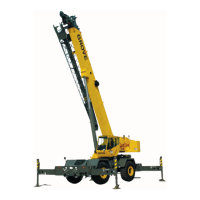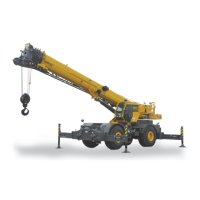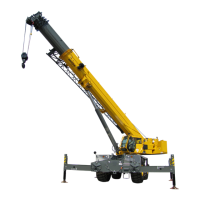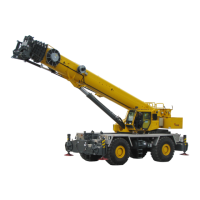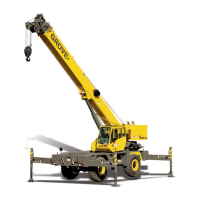HYDRAULIC SYSTEM RT880E SERVICE MANUAL
2-22 Published 11-10-2014, Control # 524-00
Procedure A - Main Control Valve Pressure
for Hoists, Boom Lift, Telescope - Check/
Adjust
Set hoist(s) boom lift and telescope inner mid retract as
follows:
1. Install pressure check diagnostic quick disconnect with
gauge onto test port at the inlet tube of the Boom Lift/
Telescope/Hoist Valve Bank (see Figure 2-11).
2. If the lift cylinder is not installed, plug the extend hose
(the larger of the two). If lift cylinder is installed, omit this
step.
3. Start engine and throttle up to full RPM. Feather into the
boom lift controller to full controller stroke (up or down)
and hold. Adjust the maximum pressure adjusting screw
on the main piston pump “in” to increase or “out” to
decrease so that a gauge pressure reading of 4000 psi
±50 (see Figure 2-10).
4. Stop engine and remove the diagnostic couplers from
the test port.
Set the telescope extend and retract as follows:
Extend
5. If the boom is installed, completely retract all sections
and boom lift down to below a horizontal boom angle
and disconnect the extend hose (the larger of the two)
running from port B, inner mid telescope section of the
VG35 directional control valve to the cylinder port block
at the back of the base section and cap adapter.
6. Install a pressure gauge into the disconnected hose
running to the directional control valve.
7. Start engine and throttle up to full RPM. Attempt to
telescope OUT by feathering into the controller to full
controller stroke. Adjust the work port relief valve “in” to
increase or “out” to decrease so that a gauge pressure
reading of 2800 psi ±50 is achieved (see Figure 2-11).
8. Stop engine and remove pressure gauge and re-connect
plumbing.
Retract
9. If the boom is installed, completely retract all sections
and boom lift down to below a horizontal boom angle
and disconnect the retract hose (the smaller of the two)
running from port A, telescope section of the VG35
directional control valve to the cylinder port block at the
back of the base section and cap adapter.
10. Install a pressure gauge into the disconnected hose
running to the directional control valve.
11. Start engine and throttle up to full RPM. Attempt to
telescope IN by feathering into the controller to full
controller stroke. Adjust the work port relief valve “in” to
increase or “out” to decrease so that a gauge pressure
reading of 3200 psi ±50 is achieved (see Figure 2-11).
12. Stop engine. Remove the pressure gauge and re-
connect plumbing.
Procedure B - Outrigger Pressures - Adjust
1. Install a pressure check diagnostic quick disconnect with
gauge onto test nipple at GP1 port of the Outrigger
Control Manifold (see Figure 2-12).
2. Start engine and throttle up to full RPM. Select and hold
the outrigger “extend or retract” switch on the cab dash.
Adjust the pressure reducing valve integrated in the
Outrigger Control Manifold “in” to increase or “out” to
decrease so that a gauge pressure of 2000 psi ±50 is
achieved (see Figure 2-12).
3. Stop engine. Remove the diagnostic coupler.
Procedure C - Oil Cooler Motor Pressure -
Adjust
1. With engine off, install a pressure check diagnostic
coupler with gauge onto the diagnostic nipple at G8 port
of the Front Steer, Swing and Accessory Manifold (see
Figure 2-9).
2. Start engine, throttle up to full RPM. Stroke lift, hoist or
telescope controller by feathering into the controller to
full stroke. Adjust the pressure reducing valve integrated
in the Outrigger Control Manifold “in” to increase or “out”
to decrease so that a gauge pressure of 3000 psi ±50 is
achieved (see Figure 2-12).
3. Stop engine. Remove diagnostic couplers and re-
connect plumbing.
Cab Tilt & Counterweight Removal Pin 2500 (17.2) +0, -25 (0.2) Cab Tilt Valve (see Figure 2-16)
Make-up Oil Manifold
200 (2.8) ± 100 (0.8)
Make-up Oil Manifold, Pressure
Reducing Valve (see Figure 2-17)
* Non-Adjustable
Valve To Be Set
Pressure
Setting PSI
(MPa)
Tolerance
PSI (MPa)
Adjustment Location

